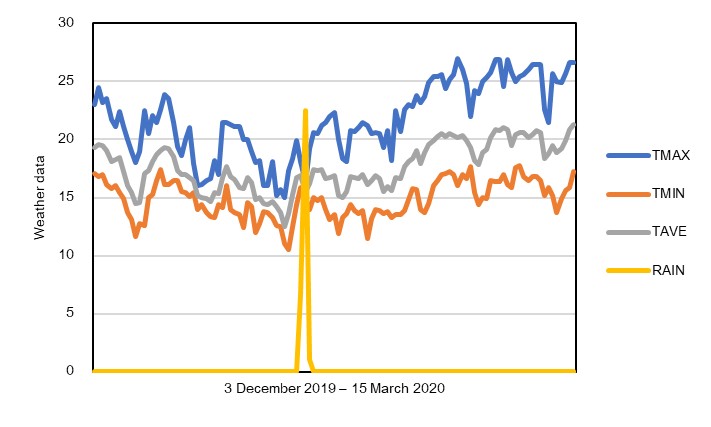การศึกษาเปรียบเทียบกระบวนการผลิตข้าวสาลีของจังหวัดเชียงใหม่ และแม่ฮ่องสอน | The Comparative Study of Wheat Production Process in Chiang Mai and Mae Hong Son Province
Main Article Content
Abstract
This research aimed to study the wheat production process in Chiang Mai and Mae Hong Son Province. The study was conducted in Ban Thung Luang, Mae Win sub-district, Mae Wang district, Chiang Mai province. And Ban Sri Don Chai, and Ban Pong, Wiang Nuea sub-district, Pai district, Mae Hong Son province. The samples were wheat farmers. Data were collected by the completionof structure interview and analyzed by descriptive statistics. The results showed that farmers' wheat production processes differed in each area, including planting method, seed rate, planting date, fertilizer application and pest management. In addition, environmental conditions such as temperature, rainfall and soil quality are different, affecting the level of productivity. The wheat yields of the Ban Sri Don Chai and Ban Pong were higher than that of Ban Thung Luang (378 and 333 kg/rai, respectively). Because farmers have production management that is suitable for the area. But Ban Thung Luang Farmers Group earned higher income from wheat production because the selling price is the main reason for the difference in income. By selling to the Royal Project and customers directly. Including processing products according to market demand. Therefore, it is a way to add value and profitsfor farmers
บทคัดย่อ
การวิจัยมีวัตถุประสงค์เพื่อศึกษากระบวนการผลิตข้าวสาลีของเกษตรจังหวัดเชียงใหม่และแม่ฮ่องสอน ดำเนินการในพื้นที่บ้านทุ่งหลวง ตำบลแม่วิน อำเภอแม่วาง จังหวัดเชียงใหม่ และบ้านศรีดอนชัยและบ้านโป่ง ตำบลเวียงเหนือ อำเภอปาย จังหวัดแม่ฮ่องสอน กลุ่มตัวอย่างเป็นเกษตรกรผู้ปลูกข้าวสาลี ใช้แบบสอบถามเป็นเครื่องมือในการเก็บข้อมูล วิเคราะห์ข้อมูลโดยใช้สถิติเชิงพรรณนา ได้แก่ การแจกแจงความถี่ ร้อยละ และค่าเฉลี่ย พบว่า กระบวนการผลิตข้าวสาลีของเกษตรกรในแต่ละพื้นที่มีความแตกต่างกัน ได้แก่ วิธีการปลูก อัตราเมล็ดพันธุ์ ช่วงวันปลูก การใช้ปุ๋ยและการจัดการโรคแมลง อีกทั้งสภาพแวดล้อม ได้แก่ อุณหภูมิ ปริมาณน้ำฝน และคุณภาพดิน แตกต่างกัน ส่งผลต่อระดับของผลผลิต โดยบ้านศรีดอนชัยและบ้านโป่ง จ.แม่ฮ่องสอน มีค่าเฉลี่ยของผลผลิตสูงกว่าบ้านทุ่งหลวง จ.เชียงใหม่ (378 และ 333 กก./ไร่ ตามลำดับ) เนื่องจากเกษตรกรมีการจัดการผลิตที่เหมาะสมกับพื้นที่ แต่กลุ่มเกษตรกรบ้านทุ่งหลวงกลับได้รายได้จากการผลิตข้าวสาลีสูงกว่า เพราะราคาขายเป็นสาเหตุหลักที่ทำให้รายได้แตกต่างกัน โดยการขายผ่านการประกันราคากับโครงการหลวงและลูกค้าที่ซื้อผ่านเกษตรกรโดยตรง รวมทั้งการแปรรูป จำหน่ายผลิตภัณฑ์ตามความต้องการของตลาด จึงเป็นแนวทางที่จะสามารถช่วยเพิ่มมูลค่า และกำไรให้เกษตรกรได้
Downloads
Article Details
References
บุญเทียม เลิศศุภวิทย์นภา. (2529). การทดสอบข้าวสาลีสำหรับที่ดอนในอำเภอฝาง. ใน สัมมนาเชิงปฏิบัติการวางแผนงานวิจัยและพัฒนาธัญพืชเมืองหนาว ปี 2529-30. 18-19 สิงหาคม 2529. (น. 330-342). กรุงเทพฯ: ศูนย์วิจัยการปรับปรุงข้าวโพดและข้าวสาลีนานาชาติ.
ไพบูลย์ พงษ์สกุล ทรรศนะ ลาภรวย และอาลัย มาศจรูญ. (2533). การปลูกข้าวสาลีหลังนาปี. ใน รายงานการสัมมนาระบบการทำฟาร์ม ครั้งที่ 7. (น. 398-408). กรุงเทพฯ: ชุมนุมสหกรณ์การเกษตรแห่งประเทศไทย.
ราเชนทร์ ถิรพร. (2537). งานวิจัยการจัดการเพาะปลูกธัญพืชเมืองหนาว รายงานการเรียบเรียงผลงานวิจัย ปี พ.ศ. 2534-2536. ใน การประชุมวิชาการธัญพืชเมืองหนาว ครั้งที่ 15 เรื่อง อนาคตของธัญพืชเมืองหนาวกับการพัฒนาอุตสาหกรรมเกษตร. 2-4 มีนาคม 2537. (น. 366-377). กรุงเทพฯ: กรมการข้าว.
ศูนย์วิจัยข้าวเชียงใหม่. (2549). คำแนะนำการปลูกข้าวสาลีคามุตอินทรีย์. (น. 27). เชียงใหม่: ดาราวรรณ.
ศูนย์วิจัยข้าวสะเมิง. (2559). ข้าวสาลี. ใน เอกสารวิชาการ. (น. 1-7). กรุงเทพฯ: กรมการข้าว.
สถาบันวิจัยข้าว. (2547). คำแนะนำการใช้ปุ๋ยเคมีในการวิเคราะห์ดินสำหรับข้าว. (น. 41). กรุงเทพฯ: กรมวิชาการเกษตร.
สาวิตร มีจุ้ย. (2530). การศึกษาอิทธิพลของช่วงวันปลูกข้าวสาลีหลังนาปี. รายงานประจำปี 2530/31 ของสถาบันวิจัยและฝึกอบรมการเกษตรลำปาง. ลำปาง: สถาบันวิจัยและฝึกอบรมการเกษตรลำปาง.
สุทัศน์ จุลศรีไกวัล และดำรง ติยวลีย์. (2525). ศึกษาระยะเวลาปลูกที่เหมาะสมของข้าวสาลี. ใน การสัมมนาเชิงปฏิบัติการธัญพืชเมืองหนาว ครั้งที่ 3. 9-11 สิงหาคม 2525. (น. 257-262). เชียงใหม่ : สำนักงานเกษตรและสหกรณ์การเกษตร.
สุทัศน์ จุลศรีไกวัล, ดำรง ติยวลีย์ และวิโชติ พัฒโร. (2524). การเปรียบเทียบพันธุ์ของ Bread wheat, Durum wheat และ Triticale เมื่อปลูกที่ระยะเวลาปลูก 4 ระยะ และที่ระดับปุ๋ยฟอสเฟต 4 ระดับ. ใน การสัมมนาเชิงปฏิบัติการธัญพืชเมืองหนาว. 17-19 สิงหาคม 2524. (น. 95-105). เชียงใหม่ : สำนักงานเกษตรและสหกรณ์การเกษตร.
Bray, R. H., & Kurtz, L. T. (1945). Determination of total, organic, and available forms of phosphorus in soils. Soil science, 59(1), 39-46.
Chujo, H. (1966). Difference in vernalization effect in wheat under various temperatures. Japanese Journal of Crop Science, 35(3-4), 177-186.
Frank, A. B., & Bauer, A. (1984). Cultivar, Nitrogen, and Soil Water Effects on Apex Development in Spring Wheat 1. Agronomy Journal, 76(4), 656-660.
Friend, D. J. C. (1966). The effects of light and temperature on the growth of cereals. The growth of cereals and grasses, 181, 199.
Hobbs, P. R. (1990). Wheat technical issues needing coordinated research in rice-wheat systems In A paper presented at Annual Wheat Workshop. January 24-26, 1990. (pp. 32-47.). Thailand: Center for Agricultural Resource System Research.
Marcellos, H., & Single, W. V. (1971). Quantitative responses of wheat to photoperiod and temperature in the field. Australian Journal of Agricultural Research, 22(3), 343-357.
Marcellos, H., & Single, W. V. (1972). The influence of cultivar, temperature and photoperiod on post-flowering development of wheat. Australian Journal of Agricultural Research, 23(4), 533-540.
Peters, D. B., Pendleton, J. W., Hageman, R. H., & Brown, C. M. (1971). Effect of night air temperature on grain yield of corn, wheat, and soybeans 1. Agronomy Journal, 63(5), 809-809.
Pratt, P. F. (1965). Potassium. Methods of Soil Analysis: Part 2 Chemical and Microbiological Properties, 9, 1022-1030.
Rawson, H. M., & Evans, L. T. (1971). The contribution of stem reserves to grain development in a range of wheat cultivars of different height. Australian Journal of Agricultural Research, 22(6), 851-863.
Sanunders, A. D. (1990). Wheat Crop Management Research in Thailand A Review and Recommendations. In A paper presented at Annual Wheat Workshop. January 24-26, 1990. (pp. 12-24) Thailand: Center for Agricultural Resource System Research.
Walkley, A., & Black, I. A. (1934). An examination of the Degtjareff method for determining soil organic matter, and a proposed modification of the chromic acid titration method. Soil science, 37(1), 29-38.
Wall, P. C., & Cartwright, P. M. (1974). Effects of photoperiod, temperature and vernalization on the phenology and spikelet numbers of spring wheats. Annals of Applied Biology, 76(3), 299-309.
Wardlaw, I. F. (1970). The early stages of grain development in wheat: response to light and temperature in a single variety. Australian Journal of Biological Sciences, 23(4), 765-774.
Yamane, T. (1973). Statistics an Introduction Analysis (3rd ed). (p. 400). New York: Harper & Row.

